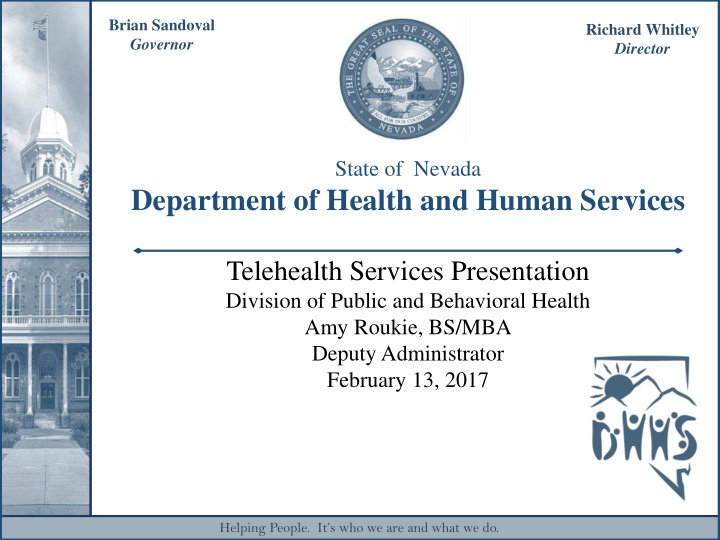



Brian Sandoval Richard Whitley Governor Director State of Nevada Department of Health and Human Services Telehealth Services Presentation Division of Public and Behavioral Health Amy Roukie, BS/MBA Deputy Administrator February 13, 2017 Helping People. It’s who we are and what we do.
Statutory Authority Assembly bill 292 of the 2015 Legislative Session enacted modifications to Chapter 629 of NRS by adding provisions to include the use of Telehealth, as follows: TELEHEALTH NRS 629.510 Legislative findings and declarations. The Legislature hereby finds and declares that: 1. Health care services provided through telehealth are often as effective as health care services provided in person; 2. The provision of services through telehealth does not detract from, and often improves, the quality of health care provided to patients and the relationship between patients and providers of health care; and 3. It is the public policy of this State to: (a) Encourage and facilitate the provision of services through telehealth to improve public health and the quality of health care provided to patients and to lower the cost of health care in this State; and (b) Ensure that services provided through telehealth are covered by policies of insurance to the same extent as though provided in person or by other means. (Added to NRS by 2015, 621) Helping People. It’s who we are and what we do. 2
Telehealth- Definition The Health Resources and Services Administration (HRSA) of the U.S. Department of Health and Human Services, defines telehealth as the use of electronic information and telecommunications technologies to support and promote long-distance clinical health care, patient and professional health-related education, public health and health administration. Technologies include videoconferencing, the internet, store-and-forward imaging, streaming media, and terrestrial and wireless communications . [1] [1] Health Resources and Services Administration Federal Office of Rural Health Policy. Available from: http://www.hrsa.gov/ruralhealth/telehealth/ Helping People. It’s who we are and what we do. 3
Telehealth in Nevada Telehealth is an integral part of the Division’s health care services especially in the areas where there are fewer healthcare services available. Rationale for Use • Healthcare access issues in rural and frontier locations • Workforce availability Helping People. It’s who we are and what we do. 4
Current Applications Nevada Rural Hospital Partners -VSee* virtual waiting room is a web-based portal for the delivery of services by clinicians to remote locations. • Rural Clinics (RC) -17 locations • Community Health Nurses (CHN) - 13 locations • UNSOM’s Psychiatric Residency program • NV-PIC (Psychology Internship Curriculum) * see next slide Helping People. It’s who we are and what we do. 5
VSee Technology VSee’s tutorials – https://VSee.zendesk.com/hc/en-us/sections/201021549-User-Manuals-Tutorials - tutorials on the virtual waiting room and cloud clinic https://VSee.com/blog/video/cloud-clinic-overview this tutorial is very helpful in describing the capabilities and uses for both providers and patients. Helping People. It’s who we are and what we do. 6
Current Applications (cont.) • Rural Mobile Crisis Team for telehealth assessments for youth-in-crisis. • Tele-therapy for clients in rural areas without access to specialty care services, conflicts or waitlists. • Psychological testing is offered where there is no on-site testing available. Helping People. It’s who we are and what we do. 7
Nevada Rural Hospital Partners Frontier Community Health Integration Project (FCHIP), CMS program. • FCHIP aims to: • Support the Critical Access Hospitals (CAH), in the rural areas; • Increase capacity in the local delivery system by enhancing payments to this system; • Treating the patient in their community, rather than having to be transferred to distant providers. 8 Helping People. It’s who we are and what we do.
Status • All NRHP hospitals are connected with the VSee technology. • Connections to other programs such as Renown is utilized. • Rural Clinics - Licensed Clinical Social Workers (LCSW’s) provide evaluations and recommendations for mental health patients. Helping People. It’s who we are and what we do. 9
Critical Access Hospitals (CAH) • There are four CAH in rural areas of the state: • Pershing General Hospital, • Mt. Grant General Hospital, • Battle Mountain General Hospital, and • Grover C. Dils Medical Center. • Renown Health utilizes the VSee telemedicine technology. • CAH system serves as the basis for healthcare in the most sparsely populated areas of the state. • Telemedicine is invaluable where limited access to specialty services exists. Helping People. It’s who we are and what we do. 10
Future Innovations Division focus: • Cutting-edge digital technologies to facilitate additional telehealth access and services to respond to a wide variety of assessment needs. • Working with partners like DETR and Social Security Disability (SSD) on eligibility assessments in rural. • Assessment of recently paroled for behavioral health issues post-release, in parole offices. Helping People. It’s who we are and what we do. 11
Challenges • Many DPBH sites have challenges with inadequate bandwidth, which limits the telehealth quality. • An increase in “originating sites” or sites where clients/consumers can go to access telehealth services in the rural communities is needed. • Additional facilities throughout rural Nevada would support a variety of social service programs in addition to access to healthcare. Helping People. It’s who we are and what we do. 12
Challenges (cont.) Connectivity • Options exist for expanded network capacity. • Working collaboratively to resolve the bandwidth and speed issues that impact quality. • Funding issues related to the use of either option has limited the progress to date. Helping People. It’s who we are and what we do. 13
Summary • Many strides have been made to improve the access to behavioral health through the use of telehealth. • Evolving technology and improved connections will aid in the effectiveness. • Additional points of access will improve the use of this advanced delivery service system over time. Helping People. It’s who we are and what we do. 14
Recommend
More recommend